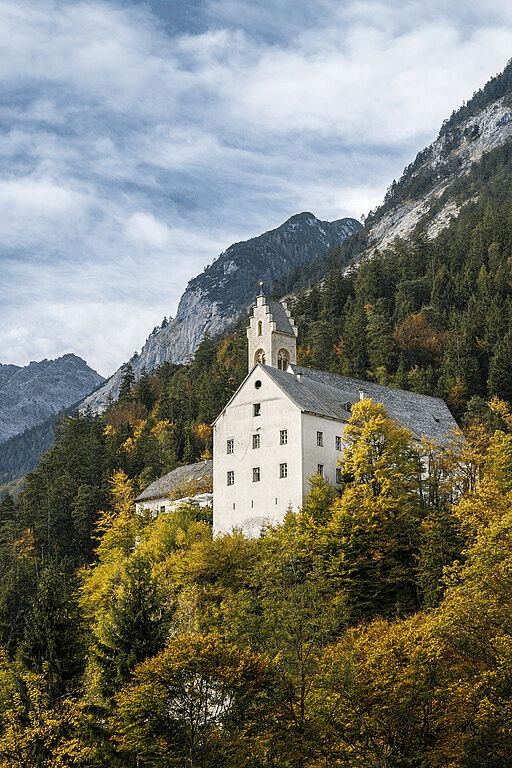Austria St. Georgenberg-Fiecht (1310)
The Boiling Blood: A Miracle of Faith in the Heart of the Inn Valley

A Quiet Haven in the Inn Valley
Nestled in the serene Inn Valley, the village of St. Georgenberg-Fiecht cradled a modest monastery steeped in centuries of quiet devotion. Monks lived here in humble prayer, their days guided by the steady hand of their abbot. It was 1310, and on a day shadowed by an approaching storm, an extraordinary event was poised to unfold.
A Peasant’s Plea
As Mass concluded at St. Georgenberg monastery, a peasant lingered, eyeing the darkening sky. Fearing the storm would strand him far from home, he approached the priest with a bold request: to take the consecrated Host with him. The priest hesitated, uneasy about entrusting the Eucharist to a layman, but relented under the man’s pleas. He wrapped the Host in a cloth, placed it in a wax container, and urged the peasant to guard it with care.
Doubt in the Tempest
As the peasant trudged homeward through howling winds and lashing rain, doubt crept into his heart. Could this small wafer truly be the Body of Christ? Overcome by curiosity—or perhaps skepticism—he stopped, pried open the container, and resolved to break the Host apart. To his horror, it began to bleed, crimson staining the cloth in defiance of his unbelief.
Awe and Return
The church soon buzzed with the peasant’s tale. Terrified, he had rushed back through the storm to St. Georgenberg, confessed his act, and surrendered the blood-stained Host to the monks. The abbot, calm amid the chaos, recognized the divine sign. Word of the bleeding Host spread like wildfire, drawing pilgrims to kneel before this proof of Christ’s presence.
A Relic is Born
With reverence, the monks preserved the miraculous Host and its stained cloth in a sacred vessel, storing them within the monastery’s tabernacle. The relic became a beacon of faith, its story echoing through Tyrol as a testament to the Real Presence.
The Blood Endures
Years turned to decades, and the wonder held fast. In 1480, a chronicler examined the relic, marveling that the blood remained "fresh as if it had come out of a wound," even after 170 years. Pilgrims flocked from far and wide to witness this enduring miracle.
An Official Seal of Truth
In 1472, Bishop George von Brixen sent a delegation to investigate the phenomenon. After careful scrutiny, they declared the miracle authentic, cementing its place in the Church’s annals. Bishops and archbishops journeyed to venerate the relic, awed by its vivid testimony.
A Journey Through Time
In 1385, the Host was solemnly transferred to the parish church in Fiecht, its fame growing stronger. By 1595, it found a new home in the Benedictine monastery of Fiecht, founded decades earlier. Yet, in 1807, Bavarian suppression scattered the monks, threatening the relic’s fate. Through providence, it endured, eventually resting in the Franciscan monastery of Schwaz.
Faith Amid the Storm of Reform
The miracle faced trials beyond the monastery walls. In 1593, as the Protestant Reformation swept through Europe, challenging Catholicism in Tyrol, the monks of St. Georgenberg stood firm. An abbot, bold in conviction, rose to defend the faith, wielding the miracle of the bleeding Host as a shield against doubt.
A Lasting Symbol of Triumph
Through storms, doubt, and reform, the Host of St. Georgenberg endured, rising beyond a relic to become a symbol of triumph. Preserved to this day, it stands as a testament to Christ’s enduring presence—a miracle that continues to inspire believers worldwide.